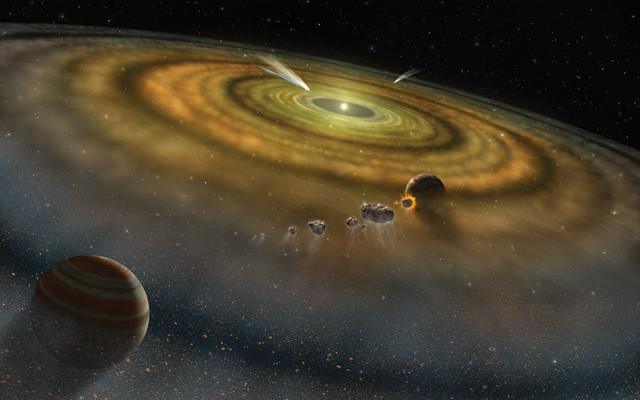
by Mary Caperton Morton Wednesday, February 13, 2019

Some of Earth's water may have originated as hydrogen in the solar nebula — the gas and dust left over after the sun's formation. Credit: NASA.
When Earth first formed, the oceans of water we know today were nowhere in sight. The long-standing consensus about where our planet’s water came from posits that it was not present during Earth’s formation and that it was later brought by chondritic materials like meteorites, asteroids and comets. But new research suggests some also came from the solar nebula — the gas and dust left over from the formation of the sun that created the planets.
In a study published in the Journal of Geophysical Research: Planets, scientists propose, based on isotopic ratios in Earth’s mantle as well as computer modeling, that 1 to 2 percent of Earth’s water originated from hydrogen in the solar nebula.
“Our conclusion does not overthrow the currently prevailing theory for the origin of Earth’s water … but rather complements its explanation,” says Jun Wu, a mineralogist at Arizona State University and lead author of the new study.
Theories of Earth’s water originating from chondritic materials gained popularity in light of isotopic studies of deuterium-to-hydrogen (D/H) ratios. The universe’s supply of natural deuterium — a heavy isotope of hydrogen — was formed almost entirely in the Big Bang and, as such, is an important cosmological probe. Comparisons between the D/H ratio of surface water on Earth and the ratios found in asteroids suggest a common source, which implies that small cosmic bodies colliding with Earth slowly brought water to the planet. Most of those collisions likely occurred during a period called the Late Heavy Bombardment beginning roughly 4 billion years ago, when Earth was blitzed by asteroids.
The major issue with the delivery-by-bombardment theory, however, is that it doesn’t adequately explain D/H ratios seen in samples of Earth’s mantle, which are much lower than ratios in chondritic materials. In the new study, Wu and his colleagues modeled how much hydrogen could have ended up in the core from different sources and constrained the results with D/H ratio measurements from mantle rocks. They found that the mantle D/H ratios were most likely influenced by hydrogen gas sourced from the solar nebula.
The researchers propose that this gas was drawn into the young, still-molten and relatively homogenous Earth — before most of the planet’s iron coalesced and sank into the core — in a process known as nebular ingassing. Eventually, most of this hydrogen, which is more attracted to iron than the deuterium, was preferentially pulled toward and into Earth’s core, ultimately creating different D/H ratios in the mantle and core than those seen on the surface.
“The concept of nebular ingassing was proposed decades ago, but our model is the first one to integrate its role into a panoramic picture of Earth’s hydrogen evolution and quantify its possible contribution to Earth’s water formation,” Wu says. “Our results show that the core is probably the largest reservoir of Earth’s bulk hydrogen and has a notably different D/H ratio than that of our ocean water and mantle hydrogen.”
The model also suggests that Earth’s core contains enough hydrogen amassed from nebular ingassing and chondritic materials to supply — if it were combined with oxygen — roughly four or five times the amount of water contained in Earth’s oceans.
The results bring “attention to the huge amount of hydrogen that may be sequestered in Earth’s core. It reminds us that the water we see in our surface oceans may be only a small fraction of the planet’s total water,” says Sara Russell, an astronomer at the Natural History Museum in London who was not involved with the study.
Although the modeling is robust, Wu says, testing the results experimentally remains a challenge. Limited sampling of the mantle is possible thanks to mantle rocks that have been brought to the surface by geological processes, but Earth’s core remains impossible to sample directly. The core has been a relatively closed system since its formation, likely exchanging little material with the mantle. So, confirming how much nebular ingassing contributed to Earth’s water relies on accurately measuring iron’s preference for hydrogen over deuterium at mantle-like conditions, a project that Wu and his colleagues are pursuing.
The new results may apply to Venus and other rocky bodies across the galaxy. “One thing all planet-forming disks have in common is that they are mostly made up of hydrogen gas, which is by far the most common element in the universe,” Russell says. This paper suggests “that many planets, in our solar system and in other planetary systems across the galaxy, would be expected to contain significant amounts of water.”
If exoplanets formed the same way as Earth, the team’s model could similarly be applied to them. In those cases, Wu says he expects Earth-sized or larger exoplanets would also contain about 1 percent of nebular water. But smaller bodies, like Mars, would likely have negligible amounts of water sourced this way because of their weaker gravitational pull on nebular gas.
© 2008-2021. All rights reserved. Any copying, redistribution or retransmission of any of the contents of this service without the expressed written permission of the American Geosciences Institute is expressly prohibited. Click here for all copyright requests.